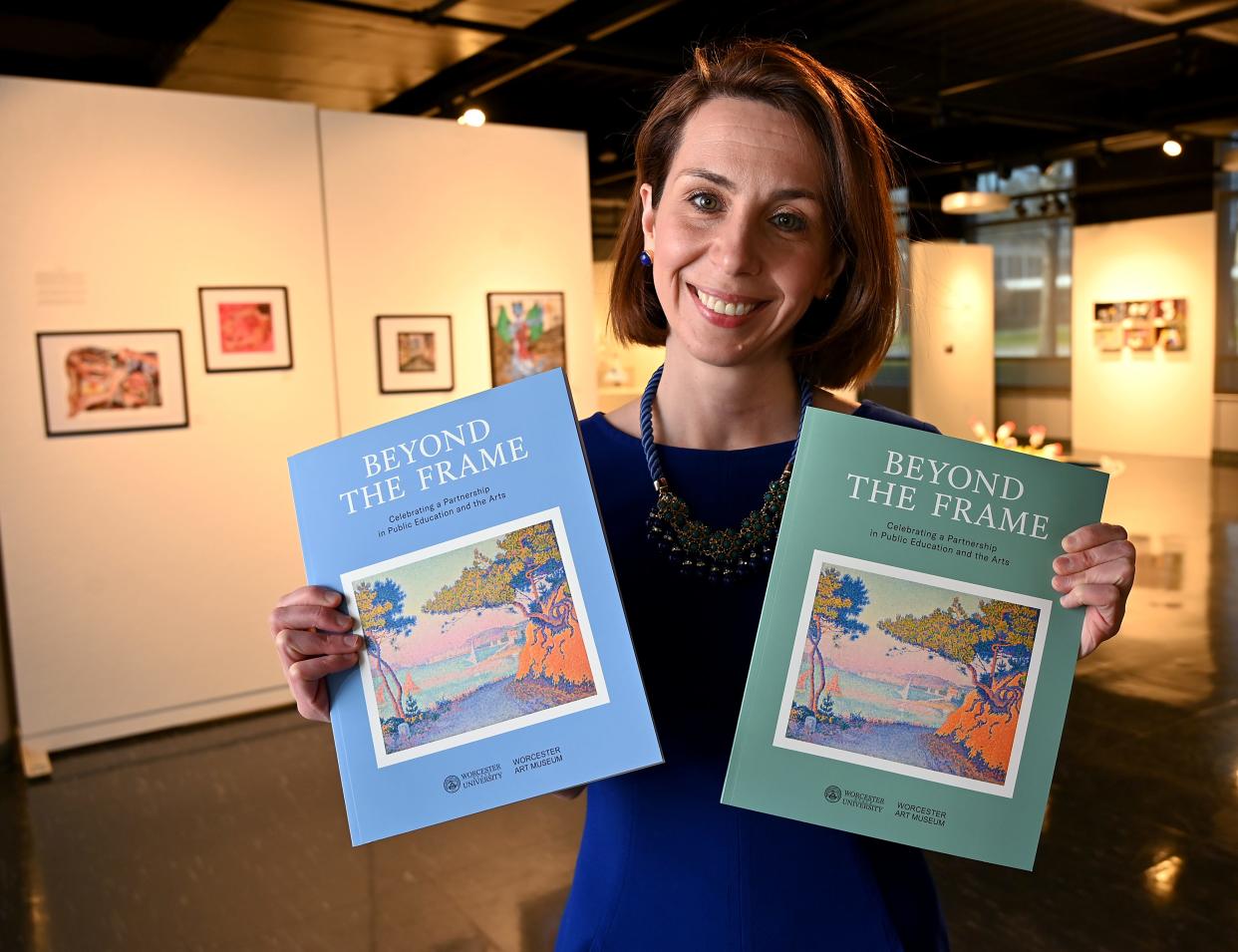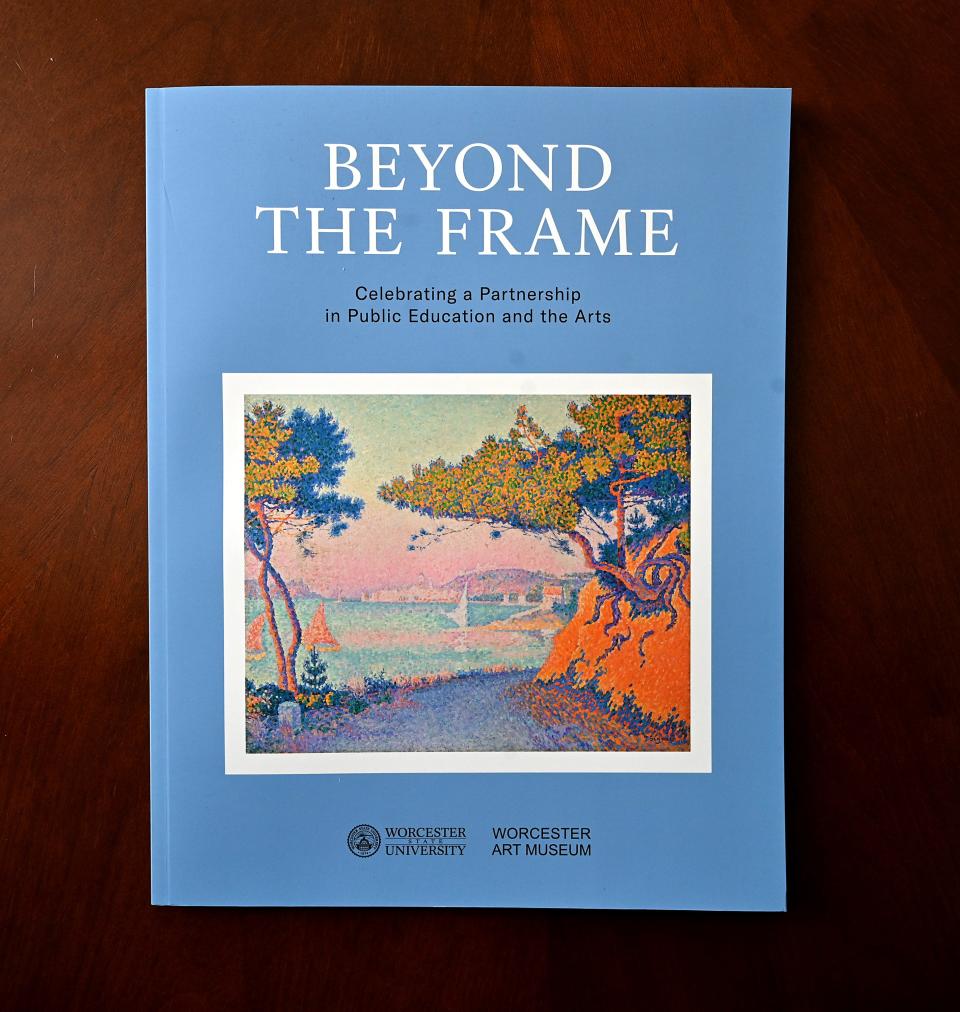'Symphony of sensibilities': In Worcester State-art museum collaboration, art inspires essays

- Oops!Something went wrong.Please try again later.
Worcester State University and the Worcester Art Museum have had a formalized and fruitful partnership dating back 10 years to 2012. So when the pandemic temporarily closed the WSU campus and shuttered the doors of WAM in 2020, a book project was seen as a way to continue the collaboration and celebrate the partnership.
"Beyond the Frame: Celebrating a Partnership in Public Education and the Arts" consists of essays by eight well-known New England writers and four WSU faculty members reflecting on specific works of art in WAM's collection.
The book also contains some surprises. Some of the essayists "chose art works connected to their expertise. Others were more quixotic and unexpected," said Heather Treseler, professor of English at WSU and the editor of "Beyond the Frame."
All of the pieces were a delight to read, she said. "I really felt like a kid at Christmas during the summer I was reading these essays."
"Beyond the Frame," jointly published by WSU and WAM, will be officially launched at WSU May 12.
"We celebrate, in this collaboration, the book that is continually being written in the circuitry between artists and their audiences, which includes our students as the next generation of makers," Treseler writes in her introductory essay.
Treseler said in a recent interview that from the beginning of the partnership, WSU president Barry M. Maloney "was very eager to have students utilize the museum."
WAM provides WSU students, faculty and staff free, unlimited access. Many university departments have held classes and conducted research projects at the museum, with disciplines ranging from science and computer programing to English and history, Treseler said.
She's seen her creative writing students grow creatively after classes at WAM.
"It's been a really lovely and enriching part of our schedules and faculty research work," she said.
Treseler suggested the idea of "Beyond the Frame" to Maloney at WSU and Matthias Waschek, the Jean and Myles McDonough director of the Worcester Art Museum.
"I thought it might be nice to have a book to celebrate this partnership and to highlight the arts in a range of academic disciplines," she said.
'An exciting project'
Maloney and Waschek "were both enthusiastic" and gave the green light. "It's been an exciting project to do during this time of transition," Treseler said.
In their jointly written preface to "Beyond the Frame," Maloney and Waschek call the essays collectively a "symphony of sensibilities" that "gives us a measure of the breadth and depth of WAM's collections and the inspiration, provocation, and replenishment that a world-class art museum offers students, faculty and the community at large."

The essayists include two Pulitzer Prize winners, Megan Marshall (biography) and Lloyd Schwartz (criticism); the poet and NAACP Image Award Finalist Lauren K. Alleyne; the Jay Hubbell Medalist Lawrence Buell, a forerunner in the field of environmental criticism; the internationally renowned novelist Gish Jen, winner of the Lannan Literary Award for fiction; the Indian-American poet and journalist Kirun Kapur, director of creative writing at Amherst College; the Cuban-American memoirist, poet and translator Pablo Medina; and the African-American social historian Anthony Walton. Worcester State professors who contributed are Erika L. Briesacher, associate professor, history; Karl R. Wurst, professor and chair, computer science; Kristin Waters, professor emerita, philosophy; and Treseler.
Treseler said that she was looking for New England writers "from a range of disciplines to write about a work of art of their choosing." Everyone had complete free rein in a choice of art work. Similarly, "I wanted a range of contributors much like a representation of our American populace."
Many of the writers had a connection to public education. Contributors donated their work without a fee, and a portion of the proceeds from the sales of "Beyond the Frame" will go toward continuing the ongoing partnership between WSU and WAM, Treseler said.
A look at Ralph Earl's work
Lawrence Buell, in his essay "Republic of Tranquility?", takes in Ralph Earl's 1800 landscape "Looking East from Denny Hill" with its commanding view of Worcester that was commissioned by Thomas Denny Jr., a wealthy landowner and merchant-manufacturer. While "tranquil and inviting," the portrait also has "redactions," Buell says, for the purpose of a peaceable stability that both Earl and Denny wanted read into the landscape for different personal reasons.
Lloyd Schwartz steps somewhat away from his field by contemplating the portraits of John Freake (a successful Boston merchant) and also Elizabeth Clarke Freake and Baby Mary, circa 1670. The artist is unknown. Schwartz's essay is titled "How ... how 'unlikely' ... - The Freake Portraits in Worcester."
"The more I look at these paintings, the more mysterious they seem, the more beautiful," Schwartz writes.
The essay was "a bit unexpected … (writing) really outside his disciplinary background and he did so brilliantly," Treseler said.
It also reflects that many people can be taken by an artwork at a museum in an orientation they are not familiar with, she said.
Quite a few of the essayists for "Beyond the Frame" were writing about WAM artworks that they saw online. But in some cases, partly as the pandemic became less severe, participants went to see the artworks in person. In a couple of instances the visit resulted in change in their essays, Treseler said.
Megan Marshall reflects on going to museums over the course of her life (going reluctantly at first, she says). Then she writes about going to WAM for the first time in June 2021 to view the 11th-century Japanese wood carving "Head of a Buddhist Guardian" having previously seen it online.
Lauren K. Alleyne relates her own experiences as a Black woman in America while writing about Faith Ringgold's 1991 "Picasso's Studio," itself a critique by a Black American artist. Alleyne's essay "flirts with being a prose poem," Treseler said.
Gish Jen calls Otto Dix's "Pregnant Woman" (1931) a "masterwork" but also sees it as "a study in contradictions."
"It's an example of how art can be provocative," Treseler said.
Treseler noted that Pablo Medina becomes "transfixed" with Adolphus Gammon's 1964 work "Holy Family," where a limp Black boy is held in the arms of his mother. Medina writes of an "outrage and anguish of the sort that either breaks us or makes us."
Literary power of art
In a wide ranging essay, "Painting with Light," Anthony Walton takes the stained glass 1898 "The Pool at Bethesda" by John La Farge to make connections that include the African American spiritual "Wade in Water."
"It's a very exciting essay to read," Treseler said.
Treseler's own introductory essay, "The Book Is Being Written," includes how she has talked to her students about "ekphrasis," the writing about a work of art's power in a literary dimension.
She also writes about how she has found the Worcester Art Museum to be a place of inspiration and replenishment, including sitting at the Chapter House from a 12th-century Benedictine monastery, and absorbing the beauty of Paul Signac's Neo-Impressionistic "Golfe Juan" (1896).
"The museum is often a spot I head to," Treseler said in the interview. "It's part of my commute home."
Treseler, who is also an award-winning poet, takes her creative writing students to WAM, something she's been able to resume doing recently as pandemic restrictions have gradually been lifted.
Her experience is that "One or two visits inspire an exponential leap in the students' creative work in a way I cannot explain. Their work takes on a greater risk, creativity, that I can't explain but I've kind of come to rely on as being a catalyst," she said.
"Poets put sensory experience into language, and working from visual arts makes that connection that much more vivid and intense of an experience … It's a truism that good readers make good writers. Visual art engages in that capacity in a different, somewhat electrifying way."
Students have especially embraced going to WAM after being unable to because of the pandemic, Treseler said.
"It was great to see my students engaging with art in the museum. I think students are eager for some art and educational experiences that will provide a framework for what they've been through."
"Beyond the Frame" has received advance praise from Malcolm Rogers, a trustee of the Worcester Art Museum and the former director of the Museum of Fine Arts in Boston.
Rogers writes, “What emerges from these essays — by award-winning historians, novelists, poets, biographers, art critics, and Worcester State University faculty members — is the way in which the museum is a classroom … This is a book that shows us the many ways in which there are to look, and be moved by, all that is found there.”
Treseler said artworks "reflect back to us."
You could say "the book is being written" anytime anyone engages with a work of art, as they have at WSU and WAM.
"In this time when we've all had great stress in our lives, I think art does have a replenishing and healing power," Treseler said. "It's important to hold onto the the forms of light and beauty."
"Beyond the Frame" is available now for sale at the WSU bookstore, the WAM gift shop, and at several bookstores in Worcester including Bedlam Book Café, Tidepool Bookshop and Root & Press.
This article originally appeared on Telegram & Gazette: In Worcester State-art museum collaboration, writers inspired by artworks

